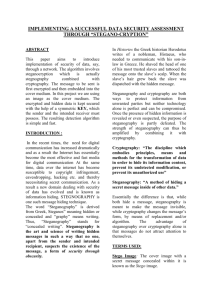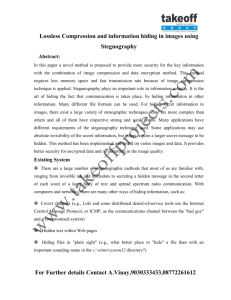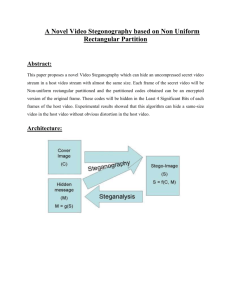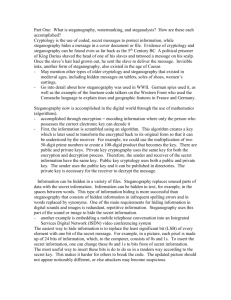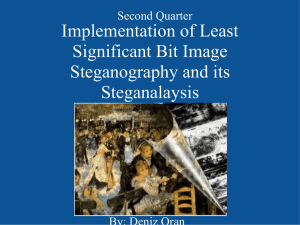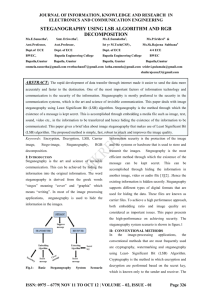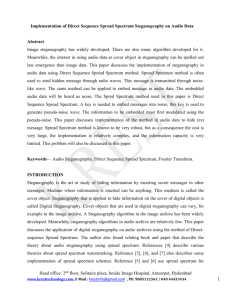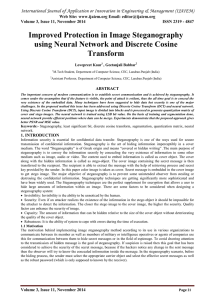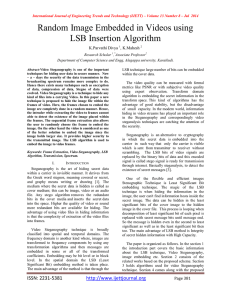High Capacity Filter Based Steganography
advertisement
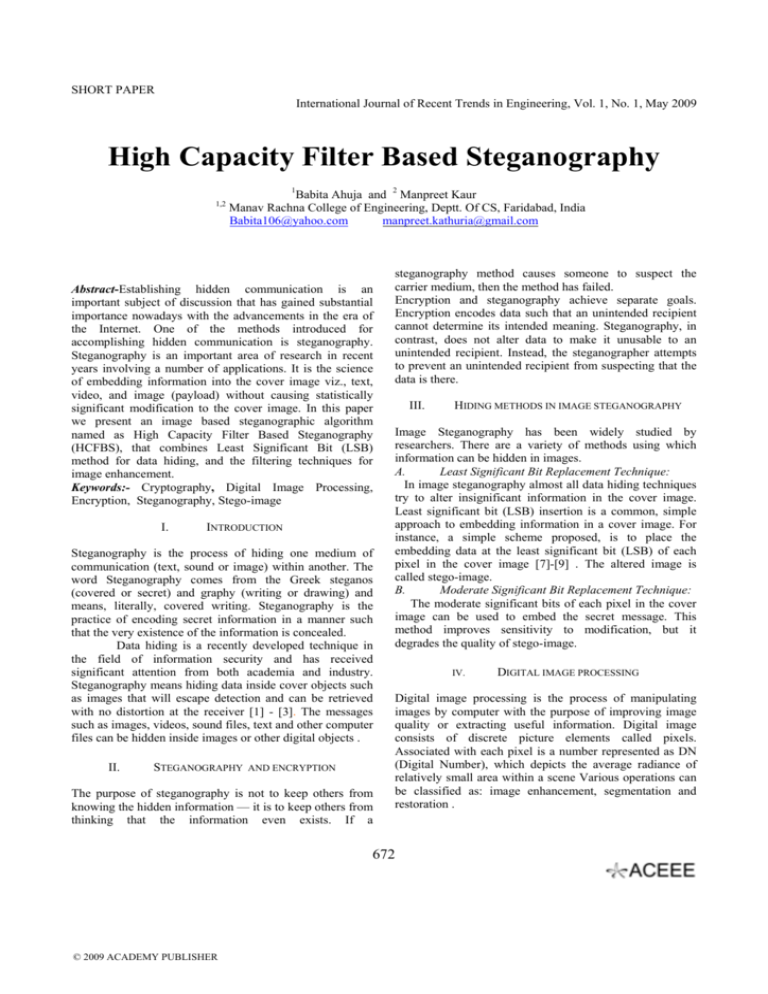
SHORT PAPER
International Journal of Recent Trends in Engineering, Vol. 1, No. 1, May 2009
High Capacity Filter Based Steganography
1
1,2
Babita Ahuja and 2 Manpreet Kaur
Manav Rachna College of Engineering, Deptt. Of CS, Faridabad, India
Babita106@yahoo.com
manpreet.kathuria@gmail.com
Abstract-Establishing hidden communication is an
important subject of discussion that has gained substantial
importance nowadays with the advancements in the era of
the Internet. One of the methods introduced for
accomplishing hidden communication is steganography.
Steganography is an important area of research in recent
years involving a number of applications. It is the science
of embedding information into the cover image viz., text,
video, and image (payload) without causing statistically
significant modification to the cover image. In this paper
we present an image based steganographic algorithm
named as High Capacity Filter Based Steganography
(HCFBS), that combines Least Significant Bit (LSB)
method for data hiding, and the filtering techniques for
image enhancement.
Keywords:- Cryptography, Digital Image Processing,
Encryption, Steganography, Stego-image
I.
INTRODUCTION
Steganography is the process of hiding one medium of
communication (text, sound or image) within another. The
word Steganography comes from the Greek steganos
(covered or secret) and graphy (writing or drawing) and
means, literally, covered writing. Steganography is the
practice of encoding secret information in a manner such
that the very existence of the information is concealed.
Data hiding is a recently developed technique in
the field of information security and has received
significant attention from both academia and industry.
Steganography means hiding data inside cover objects such
as images that will escape detection and can be retrieved
with no distortion at the receiver [1] - [3]. The messages
such as images, videos, sound files, text and other computer
files can be hidden inside images or other digital objects .
II.
STEGANOGRAPHY
AND ENCRYPTION
The purpose of steganography is not to keep others from
knowing the hidden information — it is to keep others from
thinking that the information even exists. If a
steganography method causes someone to suspect the
carrier medium, then the method has failed.
Encryption and steganography achieve separate goals.
Encryption encodes data such that an unintended recipient
cannot determine its intended meaning. Steganography, in
contrast, does not alter data to make it unusable to an
unintended recipient. Instead, the steganographer attempts
to prevent an unintended recipient from suspecting that the
data is there.
III.
Image Steganography has been widely studied by
researchers. There are a variety of methods using which
information can be hidden in images.
A.
Least Significant Bit Replacement Technique:
In image steganography almost all data hiding techniques
try to alter insignificant information in the cover image.
Least significant bit (LSB) insertion is a common, simple
approach to embedding information in a cover image. For
instance, a simple scheme proposed, is to place the
embedding data at the least significant bit (LSB) of each
pixel in the cover image [7]-[9] . The altered image is
called stego-image.
B.
Moderate Significant Bit Replacement Technique:
The moderate significant bits of each pixel in the cover
image can be used to embed the secret message. This
method improves sensitivity to modification, but it
degrades the quality of stego-image.
IV.
DIGITAL IMAGE PROCESSING
Digital image processing is the process of manipulating
images by computer with the purpose of improving image
quality or extracting useful information. Digital image
consists of discrete picture elements called pixels.
Associated with each pixel is a number represented as DN
(Digital Number), which depicts the average radiance of
relatively small area within a scene Various operations can
be classified as: image enhancement, segmentation and
restoration .
672
© 2009 ACADEMY PUBLISHER
HIDING METHODS IN IMAGE STEGANOGRAPHY
SHORT PAPER
International Journal of Recent Trends in Engineering, Vol. 1, No. 1, May 2009
Brief Description of median filter
Median Filter: It is normally used to reduce noise in an
image. How It Works
The median filter considers each pixel in the image in turn
and looks at its nearby neighbors to decide whether or not it
is representative of its surroundings. Instead of simply
replacing the pixel value with the mean of neighboring
pixel values, it replaces it with the median of those values.
.
V.
DESIGN DETAILS
This section focuses on the High Capacity Filter Based
Steganography (HCFBS).
A. Algorithm for Encoding (hiding) the data:
Problem
Definition:
Given
a
cover
Image
“Source_Image” the objective is to embed the Secret data
or file in the “Source_Image”.
Algorithm HCFBS (Encoding):
Input: Source Image, Secret_Msg
Output: Enhanced_Image, Subtracted_Image
3. Finally, The secret text message in its binary form is
extracted from 4 LSB’s of each RGB (Red , Green , Blue)
components of each pixel of stego image producing the
secret message.
VI.
The proposed HCFBS technique has been implemented ,
tested and verified. In the experiment, we used a text file of
1000 characters as the secret message whose binary code is
8000 bits long, to be hidden in the image named
secrethorse.jpg of dimensions 256 X 256. The text message
was successfully retreived from the secrethorse.jpg image.
Fig3: shows the results including the cover image, stego
image, enhanced image, subtracted_encrypted image and
the text message. Capacity , confidentiality and security of
the algorithm has been analyzed based on these results.
Secre
t Data
The steps of the algorithm are:
1. The secret text messagw in its binary form is embedded
in 4 LSB’s of each RGB (Red , Green , Blue) components
of each pixel of carrier image producing a distorted stegoimage.
2. To remove the distortion which is produced in the image
as a result of embedding the data in pixel, a filter is applied
on to the stego image known as median filter producing an
enhanced image.
3. A subtractor is applied on stego image and enhanced
image resulting in a subtracted image.
4. The subtracted image is encrypted with a private key
which is sent along with the enhanced image.
Image Enhancement Technique
applied to improve the distorted
Image
-------------
+
-----
Both of these Images
Img3 &Img4 are send
---Cover
Image
(Img1)
GetRGB(&Red,&Green,&Blue,Source_Image[i]);
for k=0 to 3 step 1
{
ENCODE(Secret_ascii_buffer[t],Red[i][k]);
StegoImage
(Img2)
Enhanced
Image
(Img3)
Send
(Img3,
Img5)
-
B. Algorithm for extracting the secret data:
Problem Defination: The Secret_Msg which was hidden is
to be retrieved from the Enhanced_Image and the
Subtracted Image as shown in Fig 2.
Algorithm HCFBS (Decoding)
Input:Enhanced_Image,Subtracted_encrypted_Image
Output:Secret_Msg
The steps of the algorithm are:
1. The private key is applied to
Subtracted_encrypted_Image to obtain original subtracted
image.
2. The adder is applied to the enhanced image and the
subtracted image to obtain the original stego image.
673
© 2009 ACADEMY PUBLISHER
RESULTS
A subtractor is
applied to the Stegoimage and the
Enhanced image
(Img1-Img2)
The
subtracted
Image
(Img4)
Img4
changed by
the private
key(Img5)
Fig.1 Encoding mechanism of HCFBS algorithm.
SHORT PAPER
International Journal of Recent Trends in Engineering, Vol. 1, No. 1, May 2009
Sender
Reciever
Key
Applied
(Img3, Img5)
(Img3, Img5)
Img3
Img5
Img4
+
Fig 3. Experimental Results using secrethorse(256 X 256) as the cover
image
(The Stego-Image)
Img2
REFERENCES
Message hidden behind
Stego-Image is retrieved
retrieved
Fig.2 Decoding mechanism of HCFBS algorithm
VII. ADVANTAGES OF THE PROPOSED SCHEME:
A. Blind Strategy: In steganography , while sending
the stego image , a strategy is followed known as blind
strategy in which the actual stego image in which data is
hidden is not sent but a modified version of stego image is
sent . The advantage of this strategy is that Steganalysis
tools can or cannot detect whether the data is hidden or not.
B. High Capacity:. The data capacity is high in proposed
algorithm as 4 bits of each byte of image are used to embed
the secret data into the image. The distortion produced
above is removed by the help of filter.
C. High Security: The proposed algorithm is highly
secure because the Stego-Image is not sent directly but the
modified form of stego image is sent.
[1] Jhonson,N.F. and Jajodia,S. "Exploring Steganography:
"Seeing the Unseen", IEEE, Computer, February 1998.
[2] K B Raja, C R Chowdary, Venugopal K R, L M Patnaik, " A Secure
Image Steganography Using LSB, DCT and Compression
Techniques on Raw Images", 3rd International Conference, ISIP,
Bangalore, p 171-176, 2005.
[3] K B Raja, C R Chowdary, Venugopal K R, L M Patnaik, " A Secure
Image Steganography on Raw Images", International Journal of
Computer Science and Network Security, Vol. 5, pp 123 -129, 2005.
[4] M. Swanson, M. Kobayashi, and A. Tewfik, “Multimedia data
embedding and watermarking technologies,” Proceedings of the
IEEE, Vol. 86, No. 6, pp. 1064-1087, June 1998.
[5] R. Wolfgang, C. Podilchuk and E. Delp, “Perceptual watermarks for
images and video,” to appear in the Proceedings of the IEEE, May,
1999
[6] R. B. Wolfgang and E. J. Delp, “Fragile watermarking using the
VW2D watermark,” Proceedings of the SPIE/IS&T Conference on
Security and Watermarking of Multimedia Contents, SPIE Vol.
3657, San Jose, CA, January 1999.
[7] F.Collin,\Encryptpic,"
http://www.winsite.com/bin/Info?500000033023.
[8] G. Pulcini, \Stegotif,"
http://www.geocities.com/SiliconValley/9210/gfree.html.
[9] T. Sharp, \Hide 2.1, 2001," http://www.sharpthoughts.org
VIII.
Conclusions
In this paper, we have presented a new algorithm in LSB
steganography with high data hiding capacity as four LSB’s
are used to hide data, high confidentiality as distortions
which can cause suspiscions for the intruders, are removed
through filtering techniques and high security as security is
being applied at two levels as explained above in the
algorithm.
674
© 2009 ACADEMY PUBLISHER


